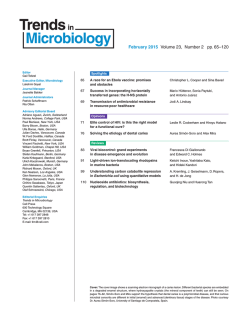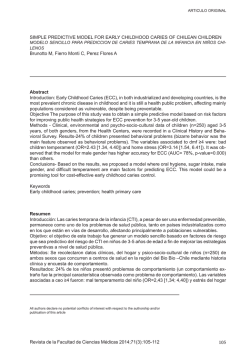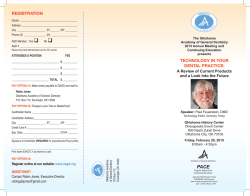
PDF (0.3 MB) - Journal of Dentistry
journal of dentistry 41 (2013) 180–186 Available online at www.sciencedirect.com journal homepage: www.intl.elsevierhealth.com/journals/jden In vitro performance of different methods in detecting occlusal caries lesions J. Gomez a,b,*, C. Zakian a, S. Salsone c, S.C.S. Pinto d, A. Taylor a, I.A. Pretty a, R. Ellwood a a The University of Manchester, School of Dentistry, Colgate-Palmolive Dental Health Unit, Williams House, Manchester Science Park, Lloyd Street North, Manchester M15 6SE, United Kingdom b Caries Research Unit UNICA, Dental Faculty, Universidad El Bosque, Cra. 7B Bis No. 132-11, Bogota, Colombia c Doctorate School of Science and Technique ‘‘Bernardino Telesio’’, Department of Physics, Universita` della Calabria, via Pietro Bucci, 87036 Arcavacata di Rende, CS, Italy d Department of Dentistry, Ponta Grossa State University, Avenida Gal. Carlos Cavalcanti 4748, Campus Universita´rio Em Uvaranas, Ponta Grossa 84030-900, Parana, Brazil article info abstract Article history: Early caries detection is essential for the implementation of preventive, therapeutic and Received 4 April 2012 intervention strategies within general dental practice. Received in revised form Objective: The aim of this study was to compare the in vitro performance of the International 2 November 2012 Caries Detection and Assessment System (ICDAS), digital photographs scored with ICDAS Accepted 4 November 2012 (ICDAS photographs), fibre-optic transillumination (FOTI), optical coherence tomography (OCT), SoproLife1 camera and two implementations of quantitative light-induced fluorescence a commercial (QLF-Inspektor Research systems) and a custom (QLF-Custom) system, Keywords: to detect early and intermediate occlusal lesions. Caries detection Methods: One hundred and twelve permanent extracted teeth were selected and assessed Visual inspection with each detection method. Histological validation was used as a gold standard. The Fibre-optic transillumination detection methods were compared by means of sensitivity, specificity, areas under receiver Quantitative laser fluorescence operating characteristic (AUROC) curves for enamel and dentine levels and with the Spear- Optical coherence tomography man’s rank correlation coefficient against histology. Results: For any enamel or dentine caries detection, the AUROC curves ranged from 0.86 (OCT) to 0.98 (ICDAS and ICDAS photographs, SoproLife1 camera) and at the dentine level from 0.83 (OCT) to 0.96 for FOTI. The correlations with histology ranged between 0.65 (OCT) and 0.88 (ICDAS and FOTI). Under in vitro conditions, the assessed detection methods showed excellent intra-examiner reproducibility. All the methods were strongly correlated with histology ( p < 0.01) except OCT which showed a moderate correlation (0.65). Conclusion: Even though all methods present similar performance in detecting occlusal caries lesions, visual inspection seems to be sufficient to be used in clinical practice for detection and assessment of lesion depth. Other methods may be useful in monitoring caries lesion behaviour. # 2012 Elsevier Ltd. All rights reserved. * Corresponding author at: The University of Manchester, School of Dentistry, Colgate-Palmolive Dental Health Unit, Williams House, Manchester Science Park, Lloyd Street North, Manchester M15 6SE, United Kingdom. Tel.: +44 161 232 4705. E-mail address: [email protected] (J. Gomez). 0300-5712/$ – see front matter # 2012 Elsevier Ltd. All rights reserved. http://dx.doi.org/10.1016/j.jdent.2012.11.003 181 journal of dentistry 41 (2013) 180–186 1. Introduction Early detection of carious lesions is highly desirable for the implementation of preventative strategies, such as fluoride remineralisation therapies, when lesions have the greatest opportunity for reversal or arrest.1,2 Detection of occlusal caries and the evaluation of the lesion depth have frequently been highlighted as a diagnostic problem. Visual and radiographic examinations are the most commonly used methods for caries detection but radiographs are unable to diagnose early enamel caries lesions reliably.2 When an occlusal lesion is detected on a bitewing radiograph, the lesion may have already reached the middle third of dentine and hence beyond the scope of remineralisation interventions.3 In response to this diagnostic dilemma, enhanced visual scoring systems reflecting the disease process have been developed. However, the conclusion of two systematic reviews in 2001 determined that the current evidence of reliability and reproducibility for visual and visual/tactile detection systems was weak.4,5 These findings led, in part, to the development of the International Caries Detection and Assessment System (ICDAS). The system is evidence based and intends to develop better diagnosis, prognosis and clinical management at the individual and population levels.6 ICDAS has shown to be an accurate and reproducible method to detect early lesions and also to detect changes in longitudinal follow-up.7–10 FOTI is a widely accepted method for caries detection and has been extensively used to detect proximal caries for which it is particularly suited.11 The literature reporting the performance of FOTI detecting caries lesions on occlusal surfaces is not extensive.12,13 Recent developments in visual scoring system such as ICDAS may be enhanced when FOTI is added.14 Non-invasive methods have been developed as potential diagnostic aids for clinicians – principally by facilitating the detection and quantification of early lesions. Quantitative light-induced fluorescence (QLF) is one such system based on the measurement of fluorescence loss following enamel demineralisation.14 This method has shown high sensitivities and specificities in detecting enamel lesions.15–17 Another method based upon the imaging and auto-fluorescence of dental tissues to detect caries is the SoproLife1 camera.18 The literature on SoproLife1 is limited to preliminary results only. OCT is a high-resolution, non-invasive imaging technique that constructs cross-sectional images of internal biological structures.19 This technology is based on the principle of optical interferometry using a low coherence light source that is split into two beams, which then are reflected back, one from the investigated tissue and the other from a reference mirror, and combined together to create an interference pattern that contains depth-information from the sample.20 Previous studies have shown that OCT has the potential to detect and quantify demineralisation based on an increase light scattering from porous structures within the tooth in in vitro caries-like models.21,22 However, these simple models did not reflect the complexity of natural lesions; in particular they were not subsurface lesions.22 Previous studies have shown the potential use of OCT to detect and quantify demineralisation based on an increase light scattering from porous structures within the tooth using in vitro caries-like models.20,21,23 The aim of this in vitro study was to compare the performance of ICDAS, FOTI, QLF (Custom and Inspektor Pro systems), SoproLife1 camera and OCT in detecting early to intermediate occlusal caries. 2. Methods 2.1. Sample A total of 112 permanent molar and premolar teeth stored in distilled water with thymol 0.1% were selected from a pool of extracted teeth from the Indiana Oral Health Research Institute, School of Dentistry, Indiana University with appropriate ethical approval from the local Ethics Committee. The occlusal surfaces were selected to provide a range of lesions ICDAS 0–4. The teeth were pooled before collection and no patient data were associated with the samples. The teeth were cleaned with water and a toothbrush and air-dried for 5 s before each detection procedure. For each tooth one examiner (JG) defined a region of interest (ROI) on the occlusal surface for assessment using each of the methods. The occlusal surfaces on the selected teeth were photographed and the ROI indicated with a rectangle shape on a power point file. Teeth were allocated an identification number that was maintained throughout the study. Seven caries detection methods were applied; ICDAS, ICDAS photographs, FOTI, OCT, QLF (Custom and Inspektor) and SoproLife. The examinations were repeated in a subsample of teeth after 7 days (30% repeat). 2.2. Examiners One examiner performed all the examinations, except for the FOTI assessment where the scores were compared and a consensus decision was taken in case of disagreement. 2.3. Examination methods 2.3.1. ICDAS/FOTI The ROI on the teeth was assessed using the ICDAS criteria10 (Table 1) by an examiner (JG) trained by an ICDAS trainer, with the aid of a WHO probe and air syringe. The examination sites were also scored visually using FOTI by two examiners (JG, RPE). The FOTI tip (0.5-mm) was placed perpendicular to the buccal and the lingual surface. The intensity of the halogen lamp (150 W) of the FOTI equipment (Schott Fibre Optics, Doncaster, UK) was set to the maximum. Scores were Table 1 – Criteria used for ICDAS and FOTI. ICDAS FOTI 0 1 Sound First visual change in enamel 2 Distinct visual change in enamel Localised enamel breakdown Underlying dentinal shadow No shadow Thin-grey shadow into enamel Wide-grey shadow into enamel Shadow <2 mm in dentine Shadow >2 mm in dentine 3 4 182 journal of dentistry 41 (2013) 180–186 compared and a consensus decision was reached using the criteria developed as part of the ICDAS programme (Table 1). The examinations were repeated in a subsample of teeth after 7 days (30% repeat). 2.3.2. QLF/white light customised imaging system Images of the teeth were captured under darkroom conditions using QLF Inspektor Pro systems and DF analysed at 5% fluorescence loss threshold using the Inspektor Pro analysis software. In addition white light and QLF images were captured using a custom high resolution QLF/white light dual imaging system. The resultant white light images were scored using ICDAS (JG). The examinations were repeated in a subsample of teeth after 7 days (30% repeat). The QLF (Custom-QLF) images were analysed in Matlab (MathWorks, Massachusetts, USA) using an algorithm previously reported15 to calculate DF at a 5% threshold. 2.3.3. SoproLife1 camera The system uses light-induced fluorescence to detect dental caries.20 The images were captured in mode I (green fluorescence) and in mode II (red fluorescence). Green fluorescence images from the occlusal surfaces were captured and DF analysed at a 5%-threshold in Matlab (MathWorks, Massachusetts, USA) using an algorithm previously reported.15 Red fluorescence images of occlusal surface were captured and the region of interest scored visually using the absence (score 0) and presence (score 1) of red fluorescence. The sites were hemi-sectioned in a buccal to lingual direction through a previously identified ROI using a 0.4 mm-thick diamond saw mounted in a microtome (Model 650 Low Speed Diamond Wheel Saw, South Bay Technology Inc.). The cut was vertical, perpendicular to the crown and the exposed surface was polished with lapping paper (30 mm) and photographed using a Jai CV-M91 camera (Jai A/S, Copenhagen, Denmark). The camera was fitted with a ring illuminator, and crosspolarisers were used to minimise specular reflection. A light shield was fitted, which also ensured the exposed surfaces were always in focus and at equal magnification.24 The images from each tooth were presented together, but the order of the teeth was randomised. The images were then viewed by each examiner on a computer screen at a constant observation distance (1.0 m). Two examiners (JG, IAP) provided a consensus score for each site. The definitive histological score was assigned following the same region of interest selected for all methods. The histological criteria to assess caries lesion depth was judged by a 7-point scale: S = sound; E1 = caries lesion limited to the outer half of enamel; E2 = caries lesion into the inner half of enamel; EDJ = caries lesion at the amelodentinal junction; D1 = caries limited to the outer third of dentine; D2 = caries limited to the middle third of dentine; D3 = caries involving the inner half of dentine. The definitive histological score was assigned following the same region of interest selected for all methods. The examinations were repeated in a subsample of teeth after 7 days (30% repeat). 2.4. 2.3.4. Images from the region of interest on the occlusal surface were captured (Thorlabs, SS-OCT 1300) and scored visually to assess the depth of caries as sound, enamel caries or caries into dentine. OCT images were captured using a swept-light source centred at 1315 nm scanned over the region of interest. The imaging depth was 3.0 mm and the width was 5.0 mm. Each tooth was placed in front of the OCT scanning probe. The axial resolution was estimated to be approximately 6 mm and the lateral resolution as 5 mm. The lesion-depth measurement was performed using the following criteria:23 0. No caries. Obtained OCT signal was the same level and shape as that of normal enamel and loss of enamel surface (cavitation) did not occur. 1. Superficial demineralisation of enamel. OCT signal intensity was enhanced within the enamel thickness but loss of enamel surface (cavitation) did not occur. 2. Enamel breakdown due to caries. Continuity of enamel surface is disconnected at the occlusal fissure, where OCT signal was intensified but limited to the enamel thickness. 3. Dentine caries. An intensified OCT signal was obtained beyond the EDJ, with or without loss of enamel surface (cavitation). The examinations were repeated in a subsample of teeth after 7 days (30% repeat). 2.3.5. Statistical assessment OCT Histology After completion of all the assessments, the teeth were embedded in acrylic blocks with the occlusal surface exposed. Data were entered into SPSS statistical software 16.0 (SPSS Inc.). Intra-examiner reproducibility of ICDAS, ICDAS photographs, FOTI and histology scores was assessed using weighted kappa statistics. To calculate sensitivity and specificity for each method disease positive states according the histological data were defined. At the sound level detection threshold all enamel and dentine lesions were classified as caries. At the enamel threshold, sound surfaces and dentine lesions were classified as disease negative and at the dentine level demineralisation extending from the outer third of dentine to the inner third of dentine was defined as disease positive. AUROC curves were calculated at the sound level detection threshold and at the dentine threshold. The strength of the association between each of the detection methods and the histology scores was evaluated with a Spearman’s correlation coefficient. 3. Results A total of 112 teeth were examined. According to the histological gold standard, 23 teeth were sound, 43 had caries from the outer half of enamel until the enamel dental junction and 46 teeth had caries in dentine. Cross-tabulations of ICDAS, ICDAS photographs, FOTI, OCT, QLF-Inspektor Pro, QLF-Custom and SoproLife1 camera (mode I) versus histology are presented in Tables 2 and 3. The intra-examiner reproducibility (weighted kappa SE) were: ICDAS (0.85 0.15), ICDAS photographs (0.84 0.08), for FOTI (0.91 0.13), OCT (0.80 0.10), Soprolife (mode I) (0.88 0.11) and histological validation (0.81 0.11). 183 journal of dentistry 41 (2013) 180–186 Table 2 – Cross-tabulation of ICDAS, ICDAS photos, FOTI and OCT scores compared to histological scores. Histology Cut-off points Sound (S/E1-D3) Enamel (E1-EDJ/S;D1-D3) Dentine (S-EDJ/D1-D3) Total ICDAS 0 1–2 3–4 Total 20 3 0 23 0 39 4 43 0 6 40 46 20 48 44 112 ICDAS photos 0 1–2 3–4 Total 21 2 0 23 0 36 7 43 0 7 39 46 21 45 46 112 FOTI 0 1–2 3–4 Total 22 1 0 23 4 36 3 43 0 10 36 46 26 60 26 112 OCT 0 1–2 3 Total 12 11 0 23 1 41 1 43 0 31 15 46 13 83 16 112 Table 3 – Cross-tabulation of QLF (Custom), QLF (Inspektor) and SoproLife compared to histological scores. Histology Cut-off points Sound (S/E1-D3) Enamel (E1-EDJ/S;D1-D3) Dentine (S-EDJ/D1-D3) Total QLF-Inspektor DF < 0.08 0.08 DF < 0.15 DF 0.15 Total 22 0 1 23 1 31 11 43 0 6 40 46 23 37 52 112 QLF-Custom DF < 0.125 0.125 DF < 0.193 DF 0.193 Total 21 1 1 23 4 27 12 43 0 3 43 46 25 31 56 112 Soprolife mode I DF < 0.101 0.101 DF < 0.167 DF 0.167 Total 22 1 0 23 2 32 9 43 0 8 38 46 24 41 47 112 AUROC curve analysis was performed to find the optimum DF QLF and SoproLife1 camera green fluorescence threshold values for enamel and dentine. The optimum value was defined by the Youden’s index (sum of sensitivity and specificity minus one for each point in the ROC curve). The optimal cut-off points corresponding to the maximum combination sensitivity and specificity observed were split into 3 cut-offs: sound enamel and dentine thresholds. Table 4 shows the correlation with histology, sensitivity, specificity and AUROC at sound enamel and dentine level cutoffs. The AUROC curves ranged from 0.86 (OCT) to 0.98 (ICDAS, ICDAS photographs, SoproLife1 camera mode I) at sound level, and at the dentine level from 0.83 (OCT) to 0.96 (FOTI). Sensitivities at the enamel level varied between 0.62 (QLFCustom) and 0.95 (OCT); specificities varied from 0.39 (OCT) and 0.94 (QLF-Custom,). At the dentine level, sensitivity ranged between 0.32 (OCT) and 0.93 (QLF-Custom) and specificity between 0.80 (OCT) and 0.93 (ICDAS). SoproLife1 mode II (red fluorescence) was dichotomised into 2 cut-offs: 0 = absence and 1 = presence of red fluorescence. The sensitivity for detecting disease with this method was 0.63 and the specificity 0.95. The correlation between the gold standard and each method was assessed by Spearman’s rank correlation coefficient and the highest correlation was found between visual detection with the ICDAS system and FOTI with the histological assessment (Table 4). All the methods were strongly associated ( p < 0.01) with the histology except for visually scored OCT that showed a moderate correlation (0.65). 4. Discussion If dentistry is to move from a restorative to a preventive and therapeutic based approach, early caries detection and quantification of lesions to monitor their arrest or progression over the time is essential. All the methods investigated in this study correlate well with histological scores. The sensitivities at the enamel level were high for ICDAS, FOTI and OCT and the specificities at the same level were high for all methods except for OCT (0.39). At the dentine level the sensitivities were high for all methods for OCT (0.32) and the specificities at this level were high for all the methods. 184 journal of dentistry 41 (2013) 180–186 Table 4 – Sensitivity, specificity, area under receiver operating characteristic (AUROC) curve and correlation between the caries detection methods and the histological scores. Detection method Spearman’s rank correlation coefficient Cut-off points Sound (S/E1-D3) Enamel (E1-EDJ/S;D1-D3) Dentine (S-EDJ/D1-D3) Sensitivity Specificity Sensitivity Specificity Sensitivity Specificity AUROC AUROC (S/E1-D3) (S-EDJ/D1-D3) (SE) (SE) ICDAS 0.88 p < 0.01 >0.99 0.87 0.9 0.87 0.87 0.93 0.98 (0.01) 0.95 (0.01) ICDAS photos 0.87 p < 0.01 >0.99 0.91 0.83 0.86 0.84 0.89 0.98 (0.01) 0.94 (0.01) FOTI 0.88 p < 0.01 0.95 0.95 0.8 0.84 0.78 0.92 0.97 (0.01) 0.96 (0.01) OCT 0.65 p < 0.01 0.98 0.52 0.95 0.39 0.32 0.98 0.86 (0.04) 0.83 (0.03) QLF (Custom) 0.76 p < 0.01 0.95 0.91 0.62 0.94 0.93 0.8 0.94 (0.03) 0.89 (0.03) QLF (Inspektor) 0.81 p < 0.01 0.98 0.95 0.72 0.91 0.86 0.81 0.97 (0.02) 0.92 (0.02) SoproLife 0.80 p < 0.01 0.97 0.95 0.74 0.86 0.82 0.86 0.98 (0.01) 0.9 (0.02) SE, standard error. A possible explanation for the poor specificity at the enamel level and sensitivity at the dentine level for OCT may be explained by the subjective visual assessment of the images rather than the use of an automated algorithm. When the analysis of the OCT scores was performed at the noncavitated and cavitated level the sensitivity and specificity increased significantly. OCT has been traditionally used in vitro for smooth surfaces and acquiring optimal images of the occlusal surface is problematic due to the varying optical penetration and surface reflectivity18 and the complex morphology of the fissures. These results therefore need to be interpreted with caution. Some studies have used algorithms to automatically calculate the depth and integrated reflectivity from the lesion area and have shown good correlation with the mineral loss.22,25 The visual assessment performed in this study was conducted to determine if demineralisation changes were visually observable. The results of the OCT analysis suggest that advanced imaging analysis methods are required to understand and interpret signs of demineralisation seen using this modality. At present, OCT is not ready to be used in clinical practice and requires further research leading to the clinical implementation of this device for the assessment and monitoring of severity of early carious lesions. This study has shown moderate sensitivity (0.65) for SoproLife1 camera mode II (red fluorescence). Red fluorescence is produced from collagen breakdown products via the Maillard reaction, only seen when caries reaches dentine.26 The present study is the first to compare the SoproLife1 method with an established technique to determine specificity and sensitivity. Limitations of the SoproLife method within the current study may be related to presence of organic deposits, porosities, and crystalline disruption, which are all able to disrupt the auto fluorescence signal, discolouring, and modifying the brightness of the hard tooth structures.18,26 Despite this, the SoproLife1 camera demonstrates very high sensitivity and specificity when green fluorescence Mode I was utilised. However, the actual SoproLife camera does not include any analysis software. In this study, the green fluorescence images were captured and DF analysed at a 5%-threshold using an algorithm previously reported.15 QLF (Custom and Inspektor) has shown excellent sensitivity at detecting disease. The moderate sensitivity at the enamel may be explained by the presence of fluorosis in sample used for this study.10 QLF will detect any demineralisation and cannot make a differential diagnosis; again it is a detection device. In such cases the importance of clinician assessment is clear as device can only detect mineral loss but cannot necessarily differentiate caries from fluorosis. Both types of QLF (Custom and Inspektor Pro systems) used in this study showed similar results. The Custom capturing system is a high resolution version of the QLF system (Inspektor BV, Amsterdam), using the same excitation wavelengths and has been used in previous studies for the detection and quantification of fluorosis14 and caries.27 QLF seems to have been rapidly adopted as a standard reference measure in clinical tests of the efficacy of preventive measures.1,28,29 FOTI has been accepted as a diagnostic aid for proximal caries for many years11 and.30 This study confirms previous findings for the FOTI technique.11,13 The findings of the photographs assessed with the ICDAS criteria showed high correlation with the histology ( p < 0.01). Photographic monitoring of the lesions (using intra oral cameras) could be an economical, practical and reliable method to use in the clinical practice.31 The ICDAS system has shown superior results when teeth are clean, dry and when the examiners are trained.7–10,32 The ICDAS results corroborate previous works32,33 where half of journal of dentistry 41 (2013) 180–186 the lesions diagnosed as ICDAS score 1 were in the inner half of enamel. Half of the lesions scored as 2 by the ICDAS system were already in the EDJ and in the outer-third of dentine, demonstrating the difficulty for ICDAS to classify lesions in enamel and in the outer third of dentine. In this study, the EDJ has been included at the enamel level to be able to report the performance of the detection methods at that threshold. However, this classification may not be critical m when clinical decisions need to be made. Lesions into the outer third of dentine are frequently non-cavitated and may also be managed in a non-operative way.3 This study relies in only one examiner for all the methods excepting for FOTI. This factor may present difficulties in generalisation due to the positive influence of particular skills of some investigators.4 In vitro studies are useful methods of comparing methods as they can be compared to a true gold standard (histological validation). However, it is unclear how results generated in vitro can be translated into the clinical situation. Further research will be required to assess the novel technologies described in this study in vivo and their use as an adjunct to visual-techniques as ICDAS may lend considerable detection yield. 5. Conclusions Even though all methods present similar performance in detecting occlusal caries lesions, visual inspection seems to be sufficient to be used in clinical practice for detection and assessment of lesion depth. Complementing traditional diagnostic methods with advanced, more sensitive methods will improve caries diagnostic routines and hence the dental care and treatment of patients. Quantitative methods may also reduce the duration and the subjects of the clinical trials measuring small changes.14 Monitoring will ensure personalised caries management and determining the status of the lesions and will allow clinicians to revaluate the effectiveness of therapies and treatment decisions. The systems described within this study may provide useful tools in the future if true preventive practice is to be facilitated within general dental services. A paradigm shift is required from a surgical to a medical model, allied with care pathways for caries management. Without effective, simple and reliable detection and quantification of early caries the profession will remain focussed on surgical interventions of cavitated lesions. Acknowledgements This study was supported by Colgate-Palmolive. The authors would like to thank Brian Bader for his assistance with preparation of the histological sections and Dr. Angeles Martinez-Mier for providing the samples for this study. The funders had no role in study design, data collection and analysis, decision to publish, or preparation of the manuscript. Roger Ellwood is employed by Colgate-Palmolive as the Director of the Colgate-Palmolive Dental Health Unit. 185 references 1. Tranaeus S, Al-Khateeb S, Bjorkman S, Twetman S, AngmarMansson B. Application of quantitative light-induced fluorescence to monitor incipient lesions in caries-active children. A comparative study of remineralisation by fluoride varnish and professional cleaning. European Journal of Oral Sciences 2001;109:71–5. 2. Neuhaus KW, Ellwood R, Lussi A, Pitts NB. Traditional lesion detection aids. Monographs in Oral Science 2009;21:42–51. 3. Ricketts DN, Kidd EA, Smith BG, Wilson RF. Clinical and radiographic diagnosis of occlusal caries: a study in vitro. Journal of Oral Rehabilitation 1995;22:15–20. 4. Bader JD, Shugars DA, Bonito AJ. A systematic review of the performance of methods for identifying carious lesions. Journal of Public Health Dentistry 2002;62:201–13. 5. Ismail AI. Visual and visuo-tactile detection of dental caries. Journal of Dental Research 2004;83:C56–66. 6. Pitts NB, Stamm JW. International Consensus Workshop on Caries Clinical Trials (ICW-CCT)—final consensus statements: agreeing where the evidence leads. Journal of Dental Research 2004;83:C125–8. 7. Ekstrand KR, Martignon S, Ricketts DJ, Qvist V. Detection and activity assessment of primary coronal caries lesions: a methodologic study. Operative Dentistry 2007;32:225–35. 8. Ismail AI, Sohn W, Tellez M, Amaya A, Sen A, Hasson H, et al. The International Caries Detection and Assessment System (ICDAS): an integrated system for measuring dental caries. Community Dentistry and Oral Epidemiology 2007;35:170–8. 9. Jablonski-Momeni A, Stachniss V, Ricketts DN, HeinzelGutenbrunner M, Pieper K. Reproducibility and accuracy of the ICDAS-II for detection of occlusal caries in vitro. Caries Research 2008;42:79–87. 10. Ferreira Zandona A, Santiago E, Eckert G, Fontana M, Ando M, Zero DT. Use of ICDAS combined with quantitative lightinduced fluorescence as a caries detection method. Caries Research 2010;44:317–22. 11. Mitropoulos CM. A comparison of fibre-optic transillumination with bitewing radiographs. British Dental Journal 1985;159:21–3. 12. Ashley PF, Blinkhorn AS, Davies RM. Occlusal caries diagnosis: an in vitro histological validation of the electronic caries monitor (ECM) and other methods. Journal of Dentistry 1998;26:83–8. 13. Cortes DF, Ekstrand KR, Elias-Boneta AR, Ellwood RP. An in vitro comparison of the ability of fibre-optic transillumination, visual inspection and radiographs to detect occlusal caries and evaluate lesion depth. Caries Research 2000;34:443–7. 14. Pretty IA. Caries detection and diagnosis: novel technologies. Journal of Dentistry 2006;34:727–39. 15. de Josselin de Jong E, Sundstrom F, Westerling H, Tranaeus S, ten Bosch JJ, Angmar-Mansson B. A new method for in vivo quantification of changes in initial enamel caries with laser fluorescence. Caries Research 1995;29:2–7. 16. Angmar-Mansson B, ten Bosch JJ. Quantitative light-induced fluorescence (QLF): method for assessment of incipient caries lesions. Dentomaxillofacial Radiology 2001;30:298–307. 17. Shi XQ, Tranaeus S, Angmar-Mansson B. Comparison of QLF and DIAGNOdent for quantification of smooth surface caries. Caries Research 2001;35:21–6. 18. Terrer E, Koubi S, Dionne A, Weisrock G, Sarraquigne C, Mazuir A, et al. A new concept in restorative dentistry: lightinduced fluorescence evaluator for diagnosis and treatment. Part 1. Diagnosis and treatment of initial occlusal caries. Journal of Contemporary Dental Practice 2009;10:E086–94. 186 journal of dentistry 41 (2013) 180–186 19. Huang D, Swanson EA, Lin CP, Schuman JS, Stinson WG, Chang W, et al. Optical coherence tomography. Science 1991;254:1178–81. 20. Jones RS, Darling CL, Featherstone JD, Fried D. Imaging artificial caries on the occlusal surfaces with polarizationsensitive optical coherence tomography. Caries Research 2006;40:81–9. 21. Wang XJ, Milner TE, de Boer JF, Zhang Y, Pashley DH, Nelson JS. Characterization of dentin and enamel by use of optical coherence tomography. Applied Optics 1999;38:2092–6. 22. Kang H, Jiao JJ, Lee C, Le MH, Darling CL, Fried D. Nondestructive assessment of early tooth demineralization using cross-polarization optical coherence tomography. IEEE Journal of Selected Topics in Quantum Electronics 2010;16:870–6. 23. Shimada Y, Sadr A, Burrow MF, Tagami J, Ozawa N, Sumi Y. Validation of swept-source optical coherence tomography (SS-OCT) for the diagnosis of occlusal caries. Journal of Dentistry 2010;38:655–65. 24. Taylor AM, Satterthwaite JD, Ellwood RP, Pretty IA. An automated assessment algorithm for micro-CT images of occlusal caries. Surgeon 2010;8:334–40. 25. Fried D, Xie J, Shafi S, Featherstone JD, Breunig TM, Le C. Imaging caries lesions and lesion progression with polarization sensitive optical coherence tomography. Journal of Biomedical Optics 2002;7:618–27. 26. Terrer E, Raskin A, Koubi S, Dionne A, Weisrock G, Sarraquigne C, et al. A new concept in restorative dentistry: LIFEDT-light-induced fluorescence evaluator for diagnosis and treatment. Part 2. Treatment of dentinal caries. Journal of Contemporary Dental Practice 2010;11:E095–102. 27. Pretty IA, Ellwood RP. Comparison of paired visual assessment and software analyses of changes in caries status over 6 months from fluorescence images. Caries Research 2007;41:115–20. 28. Karlsson L. Caries detection methods based on changes in optical properties between healthy and carious tissue. International Journal of Dentistry 2010. http://dx.doi.org/ 10.1155/2010/270729. 29. Feng Y, Yin W, Hu D, Zhang YP, Ellwood RP, Pretty IA. Assessment of auto fluorescence to detect the remineralization capabilities of sodium fluoride, monofluorophosphate and non-fluoride dentifrices. A single-blind cluster randomized trial. Caries Research 2007;41:358–64. 30. Deery C, Care R, Chesters R, Huntington E, Stelmachonoka S, Gudkina Y. Prevalence of dental caries in Latvian 11- to 15-year-old children and the enhanced diagnostic yield of temporary tooth separation, FOTI and electronic caries measurement. Caries Research 2000;34:2–7. 31. Pitts NB, Richards D. Personalized treatment planning. Monographs in Oral Science 2009;21:128–43. 32. Diniz MB, Rodrigues JA, Hug I, Cordeiro Rde C, Lussi A. Reproducibility and accuracy of the ICDAS-II for occlusal caries detection. Community Dentistry and Oral Epidemiology 2009;37:399–404. 33. Braga MM, Mendes FM, Martignon S, Ricketts DN, Ekstrand KR. In vitro comparison of Nyvad’s system and ICDAS-II with lesion activity assessment for evaluation of severity and activity of occlusal caries lesions in primary teeth. Caries Research 2009;43:405–12.
© Copyright 2026





